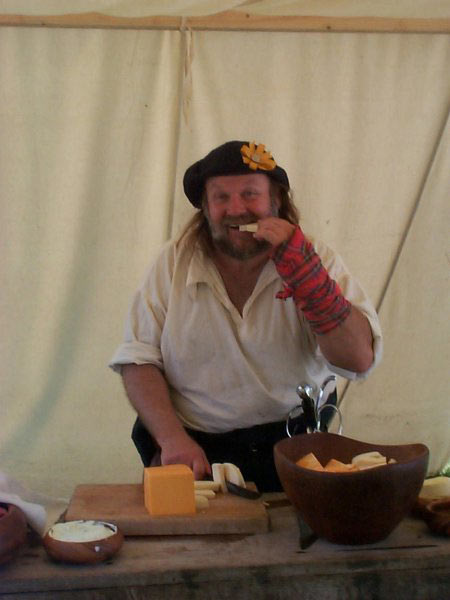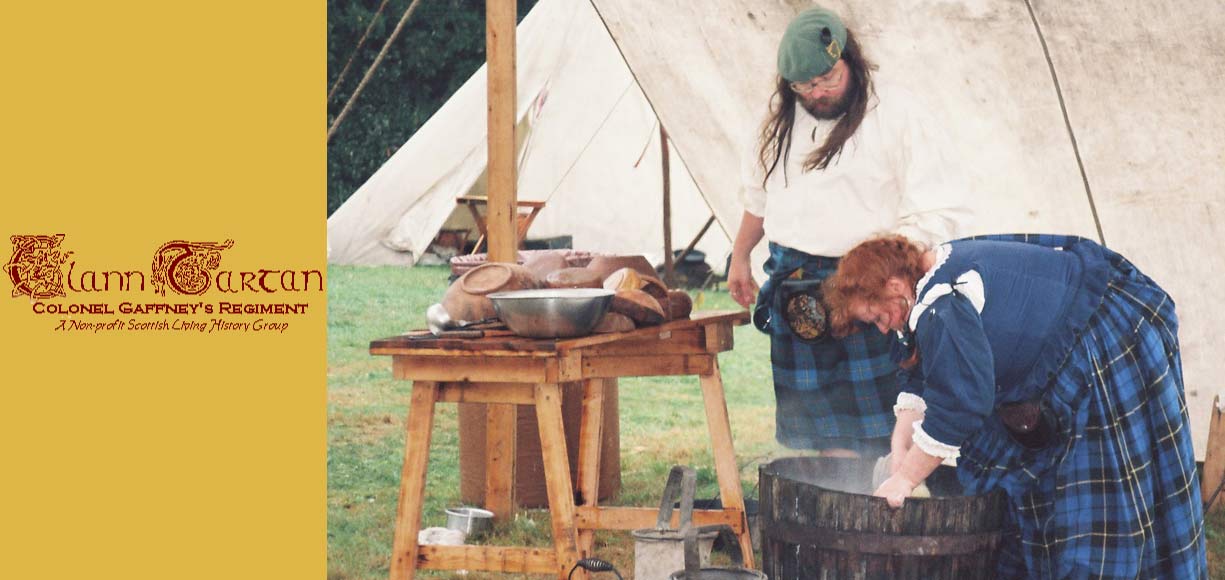The History of the Fork
In looking for something to write about to contribute to Clann, I came across a piece in Extraordinary Origins of Everyday Things, and thought "here's something that I bet nobody else had thought to write about." The fork actually has a very long history, even being mentioned in the Old Testament: "And the priests' custom with the people was, that when any man offered sacrifice, the priests' servant came, while the flesh was in seething, with a fleshhook of three teeth in his hand, And he struck it into the pot ... all that the fleshhook brought up the priest took for himself" (1 Sam. 2:13-14) So while this claw-like fork was a fairly common cooking and fire keeping utensil and even popped up now and then on the table through the Middle Ages and beyond, the fork as a dining utensil was far from being a common item.
Forks did appear as a way to eat your meal at the table as early as the fourth century, having been introduced there from the East. But even then, it was only occasionally and at elegant dinner parties. To the west the fork remained an oddity, or worse. In the eleventh century, a Byzantine princess created a stir in Venice. The princess came to marry the future Doge, Domenico Selvo, and at one of the celebrations in her honor she dared to refuse to eat with her hands. Instead, she had one of her eunuchs cut her food into little pieces she was able to eat with a golden fork. The socialites of the era proclaimed it to be total decadence and when the princess died shortly after of some wasting disease, the Cardinal Bishop of Ostia denounced her with the passage: "Of the Venetian Doge's wife, whose body, after her excessive delicacy, entirely rotted away."
Needless to say, the fork didn't catch on just yet. However by the middle of the fourteenth century, it did start showing up occasionally in the inventories and wills of the nobles and the rich. An inventory of property left by HenryVII included "Item, one Case wherein are xxi knives and a fork, the hafts being crystal and chalcedony, the ends garnished with gold". The inventory of King Henry I in 1307 included thousands of royal knives, hundreds of spoons and just seven forks; six of silver, one gold. Many of these forks seemed to be more for show and as a conversation piece, not something to actually be used on a regular basis.
Besides being bejeweled, these forks are not like those we're used to now. The tines, usually only two, were short and straight, not curved. Forks weren't being used to bring food from the plate to the mouth, but instead were used to spear a piece of food, lift it from the serving plate or bowl and shake any excess sauce from it before grabbing it with your fingers (and just the thumb and first two fingers at that) to pop in your mouth.
Through the fifteenth and sixteenth centuries the use of forks slowly spread across Italy and Spain, and was introduced to France in 1533 by Catherine de Medici, daughter of the ruler of Florence when she married the future French King Henry II. It took the diners a while to get used to using the unfamiliar utensil; half the food would fall from the fork between their plate and mouth. But the use of the fork slowly spread from the King's palace to the wealthy homes throughout France.
The English were quite a bit behind the French here, maybe because they were naturally suspicious of things from abroad. A book published in 1611 held the claim by a Thomas Coryate, a traveler who claimed to be the first man in London to eat with a fork. His friends would ridicule him, calling him furciferus, which meant, "pitchfork handler" (and is the word that also gave the fork it's name). Coryate's response was, "Wait and see; one day you each will have a fork. Mark my words!" Sure enough, within a few years, every member of the British royal family and the court possessed a fork. And by the mid 1600's, eating with a fork had nearly become the norm for the upper classes and nobility of England. Then slowly the used trickled down to the craftsmen, merchants, and as styles and customs usually did, eventually reached the poor.
Even as forks were gaining in popularity amongst those in the upper classes, many hosts, inns, and even the palaces did not provide table settings for dinner guests. By the mid-1600's cutlery centers such as Sheffield, England were not producing large number of forks along with knives and spoons. Most were either cast in molds or stamped from bars of metals such as steel or silver with handles carved of precious or semiprecious materials like rock crystal and ivory. In the upper classes, the beauty and rarity of the materials on ones utensils became a mark of social status.
By the end of the 1600's, manufacturers were adding additional tines, usually a third to denote the old custom of eating with just the first three fingers, and sometimes a fourth as we generally see now. This, along with the curving of the tines, made it much easier for diners to spear and scoop at the pieces of meats and vegetables. The acceptance of the fork also led to changes in dinner knives. Before now, the tip of the knife is what was used to spear your food, bring it to your spoon, and then eat. Since this was no longer a necessity, knives where now being produced with rounded tips. Some credit Cardinal Richelieu, a French religious and political leader, for this change. The story told is that the Cardinal frequently entertained a nobleman who had the nasty habit of picking hit teeth with the point of his knife. Out of disgust for this habit, the Cardinal ordered the tips of all the knives in his inventory to be ground down. This style then spread to others in the French court. The new style of dinner knife was further spread by King Louis XIV of France. In order to discourage violence, it was made illegal for anyone to carry a pointed knife, for cutlers to make them, or for an innkeeper to put them on their tables. He even went as far as ordering all existing knives be ground down as well. The French were quick to obey this law, and the new style of knives soon spread to England and the rest of Europe. Besides this influence, King Louis XIV was also the first host in Europe to provide complete sets of dinnerware for his guests; visitors to his palaces would no longer have to provide their own utensils.
While forks and other dinnerware were now common items throughout Europe and even spreading into the American Colonies, matched sets were still something of a status item, owned only by the well-to-do, and most were made of silver. It wasn't until the industrial revolution of the late 1700's that matching sets of table utensils would be common for the common folks.
So how does all this affect those of us in Clann? It would seem that this is a case where modern hygiene concerns may over-ride some of our historical accuracy. In 1630, the fork was still a rarity in England, probably more so in Scotland. Most of when dining with family would have been sharing a common bowl and eating with our fingers, using only knives and spoons (as the Manual does point out, "forks were uncommon in our period", possibly to the point of being an object of ridicule for those seen using them.) Those who's characters came from France, Italy or Spain, or had traveled there would definitely be aware of forks, and may have brought their own set with them. An Englishman would probably see them more of a status item, something to be made from precious metals and shown off, but rarely used. and would probably not have it with them in a war camp situation. Those choosing to use forks and who wish to stay as accurate as possible would probably want to stick to a fork with two, straight tines.
Sources
From Hand to Mouth
Giblin, James Cross. New York: Thomas Y. Crowell, 1987.
Fast and Feast - Food in Medieval Society
Henisch, Bridget Ann. University Park, PA: The Pennsylvania State University Press, 1976
Extraordinary Origins of Everyday Things
Panati, Charles. New York: Harper & Row, Publishers, 1987

